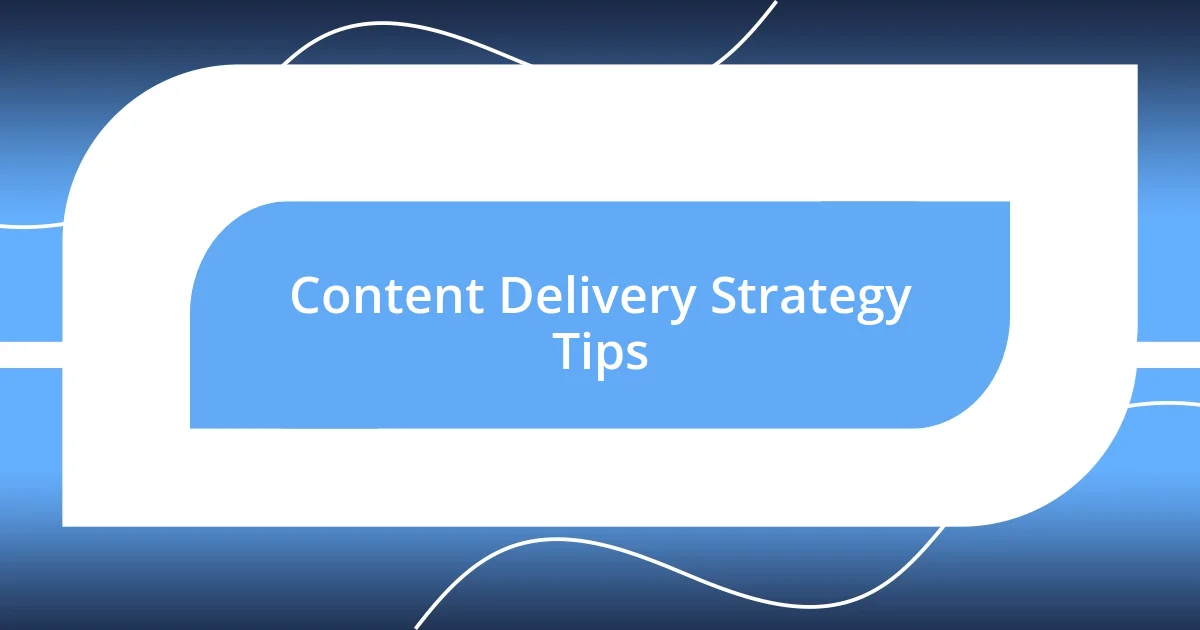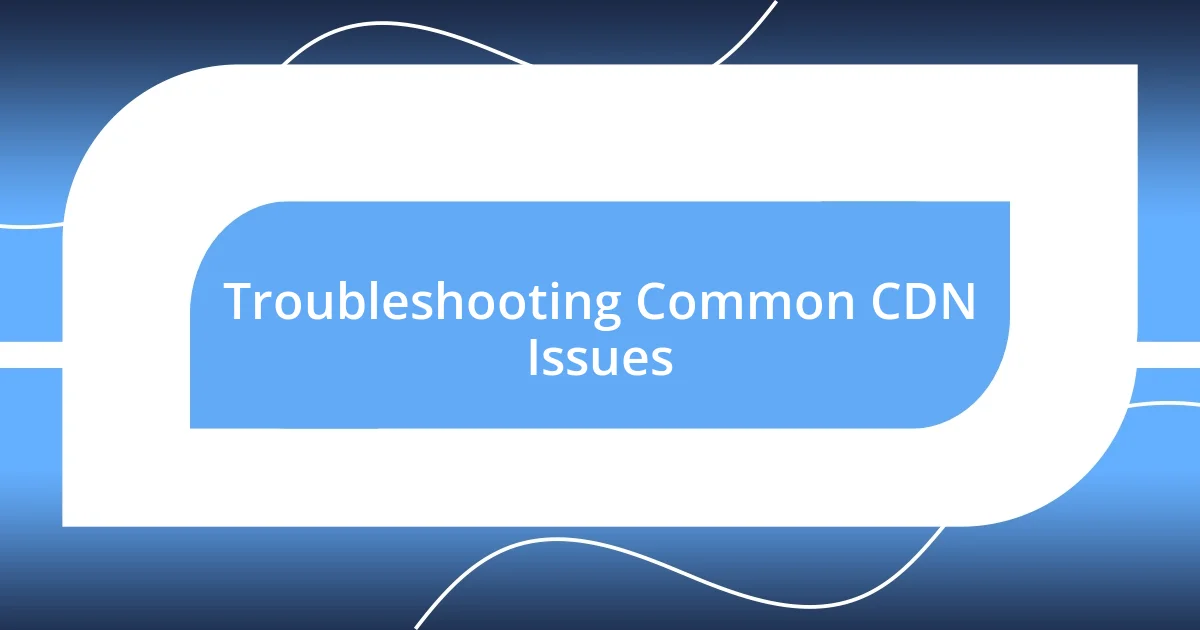Key takeaways:
- Utilizing a CDN significantly improves website performance by enhancing load times, reliability, security, and cost efficiency, which directly impacts user satisfaction and SEO rankings.
- Choosing the right CDN provider is crucial; consider features based on your website’s needs, assess pricing structures, and ensure reliable customer support.
- Regular monitoring and proactive troubleshooting of CDN performance issues can prevent slow load times and enhance user experience, leading to higher engagement and conversion rates.

Understanding CDN Basics
A Content Delivery Network, or CDN, is essentially a system of distributed servers designed to deliver web content more efficiently. I remember the first time I realized how crucial a CDN could be when a friend’s e-commerce site crashed during a big sale. It was heartbreaking to see potential customers unable to access the store—is that something you would want to experience with your website?
At its core, a CDN stores copies of your website’s static content—like images and scripts—closer to the users. I often think about the difference it makes when my favorite blogs load instantly, regardless of where I am in the world. It’s fascinating to consider how much faster a user can access information when it’s delivered from the nearest geographical server instead of a primary server often located miles away.
One of the standout benefits of using a CDN is improved load times, which can significantly enhance user experience and SEO rankings. Have you ever clicked on a website only to be met with frustratingly slow loading times? I certainly have, and it makes me wonder how many potential customers or readers we lose with every second of delay.

Benefits of Using CDNs
Utilizing a CDN can markedly elevate your website’s performance. I still remember the relief I felt when a client’s site, previously bogged down in loading times, transformed into a swift experience thanks to CDN implementation. The visitors started to stay longer, and I could almost feel the shift in the atmosphere—the excitement of users quickly finding what they needed rather than bouncing away in frustration.
The benefits of using CDNs extend beyond just speed. Consider how they contribute to improved security, reduced bandwidth costs, and increased scalability. These advantages become crucial during high-traffic events, like product launches or holiday sales. Here’s a snapshot of the perks:
- Faster Load Times: Enhanced speed leads to better user experience.
- Improved SEO: Search engines favor sites with quick response times.
- Increased Reliability: CDNs can reduce downtime by distributing traffic across multiple servers.
- Enhanced Security: Protection against DDoS attacks and data breaches.
- Cost Efficiency: Reduced data transfer costs by caching content.
Seeing these elements come together reminds me of how efficiently technology can resolve real business challenges. It’s truly empowering to leverage a CDN and observe the direct impact on user satisfaction and overall performance.

Choosing the Right CDN Provider
When choosing a CDN provider, it’s important to assess your specific needs. From my experience, different providers offer varying features that align better with certain types of websites—e-commerce platforms, for instance, might prioritize media delivery speed, while news sites might need scalability to handle burst traffic. I vividly recall the time I switched providers for a high-traffic campaign; the new CDN not only improved loading speeds significantly but also offered great analytics tools that helped refine our future strategies.
Pricing structures can also vary significantly among CDN providers, and this is where I believe careful consideration is key. Some might offer flat fees, while others charge based on usage. Reflecting back, I once encountered a provider with a pay-as-you-go model, and it was a double-edged sword—ideal for startups with fluctuating demands but it turned out to be more expensive than anticipated during peak usage. Understanding your budget in relation to anticipated traffic and future growth is essential.
Lastly, customer support should never be overlooked in your decision-making process. In my earlier days, I relied heavily on support during the initial setup phase and it made all the difference. Having a provider with responsive and knowledgeable customer service saved me countless headaches when technical issues arose. It’s similar to having a trusty co-pilot—you want someone who can guide you through the twists and turns of the digital landscape.
| CDN Provider | Key Features |
|---|---|
| Provider A | High Speed, Strong Security, Good Analytics |
| Provider B | Cost-Effective, Flexible Pricing, Excellent Support |
| Provider C | Scalability, CDN edge computing, Global Reach |

Performance Optimization with CDNs
Performance optimization with CDNs is a game changer that I’ve experienced firsthand. I recall a particularly busy week when a client’s website was overwhelmed with traffic. Leveraging a CDN helped distribute the load efficiently, transforming a potentially disastrous scenario into a seamless user experience. It’s almost magical how quickly everything loads when the right technology is in play.
One element I truly appreciate is the caching capabilities that CDNs offer. Have you ever wondered how some sites load instantly, even during peak times? That’s the power of cached content. When static resources are stored closer to users, it reduces the distance data must travel. This not only speeds up load times but also decreases the strain on the origin server. I remember being astounded by the reduction in server response times on a project after implementing caching strategies through a CDN.
Moreover, I believe that performance optimization with a CDN can significantly enhance user engagement. Picture this: a potential customer abandons their cart simply because the checkout page takes too long to load—frustrating, right? In my experience, optimizing performance with a CDN not only prevents such scenarios but fosters a more enjoyable shopping experience. This investment in speed directly contributes to higher conversion rates and customer satisfaction, which is the ultimate goal, isn’t it?

Content Delivery Strategy Tips
When developing a content delivery strategy, leveraging edge servers effectively is crucial. I once worked on a large project where the geographic distribution of our users was diverse. By utilizing edge servers strategically, we minimized latency for users across different regions, resulting in a marked improvement in loading times. It felt rewarding to witness clients’ delight as their websites performed faster than ever, creating more engagement.
A solid strategy should also include regular performance monitoring. I learned this the hard way; not too long ago, I neglected to analyze our CDN’s metrics regularly. We were blindsided by an uptick in latency after an update. By implementing a routine check and employing tools to track performance, I now stay ahead of potential issues. It’s like having a safety net—one that allows you to catch problems before they catch you.
Additionally, understanding the timing of cache purging can make or break your content delivery strategy. I recall an instance where I manually purged the cache after a critical update, which felt liberating. Knowing that users were seeing fresh content instantly was satisfying. Set a clear strategy for cache freshness that aligns with your content update cycles, and you’ll keep your audience engaged with relevant information right when they need it. After all, who wants stale content in a fast-moving digital world?

Monitoring CDN Performance
Monitoring the performance of your CDN is vital for ensuring that your content is delivered efficiently. There was a time when I overlooked this aspect and was met with user complaints stemming from slower load times. That experience taught me a valuable lesson: to view monitoring not as an obligation, but as a means to proactively enhance the user experience. Have you ever felt that sinking feeling when you realize something’s not right? Consistent monitoring helps prevent those moments.
I’ve found that using performance metrics can be enlightening. Checking stats like latency, cache hit ratios, and geographic load times gives you a comprehensive view of your CDN’s effectiveness. I remember one afternoon spent poring over graphs, and it was like solving a puzzle. By identifying and addressing spikes in latency, I was able to make adjustments that kept users happy. It’s incredible how a little data can go a long way!
Finally, I can’t stress enough the importance of alert systems. Setting up notifications for performance anomalies has saved me countless headaches. Picture this: I once received an alert during a major promotion, notifying me of sudden latency spikes. Thanks to this early warning, I could jump in and troubleshoot before it affected sales. Incorporating such measures into your monitoring strategy not only safeguards user experience but can also lead to those ‘aha’ moments where you discover opportunities for further optimization.

Troubleshooting Common CDN Issues
Troubleshooting CDN issues can sometimes feel like unraveling a mystery. I vividly recall a situation where a client reached out, frustrated by an entire section of their website not loading correctly. It turned out that a misconfigured DNS setting was routing traffic to the wrong edge node. Have you ever faced such a head-scratcher? It made me realize how critical it is to double-check DNS settings during setup and after any significant changes.
Another common issue I’ve encountered is version control in asset delivery. There was a project where users were experiencing outdated styles and functionality because cached resources weren’t being updated. It was like sending guests invitations with the wrong date! I discovered that employing versioning in asset URLs could effectively force a refresh of cached files. It’s a simple practice, but one that can save you from countless headaches down the line. Have you considered how version control might streamline your updates?
Lastly, I can’t emphasize enough the importance of communicating with your CDN provider. I remember reaching out during an unexpected outage, which turned out to be due to network congestion. The support team was quick to diagnose the issue, but I often wonder how many people hesitate to connect for fear of seeming inept. Don’t shy away from seeking help; your CDN provider can be a valuable ally in troubleshooting. Being proactive about these common issues not only enhances your CDN performance but also builds a strong foundation for user satisfaction.














